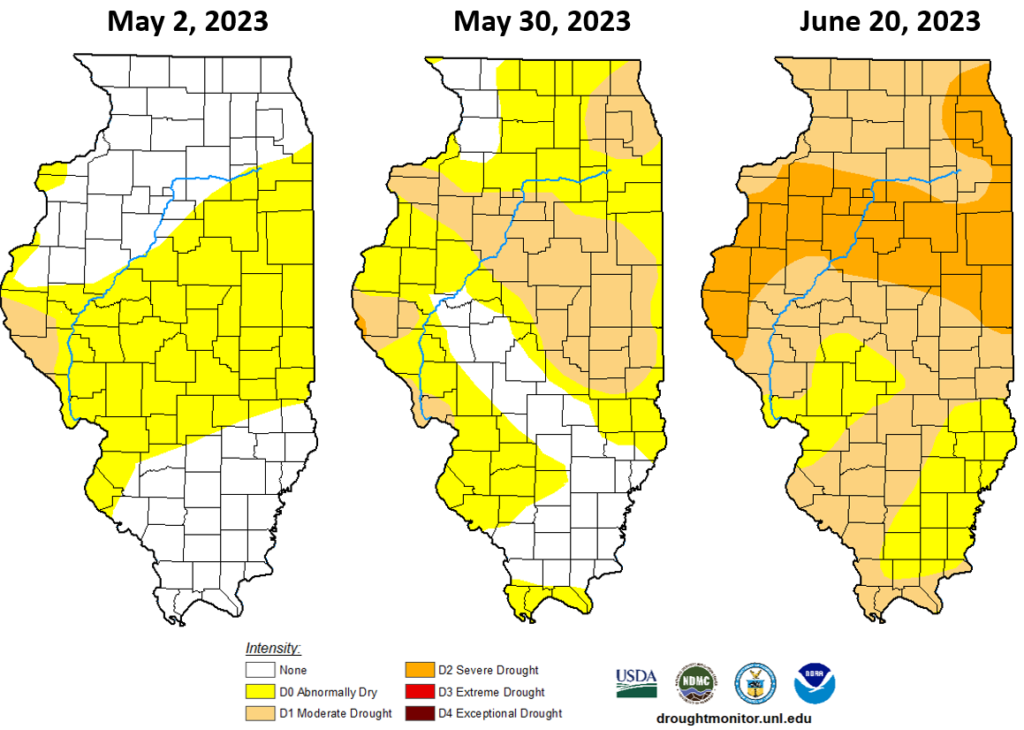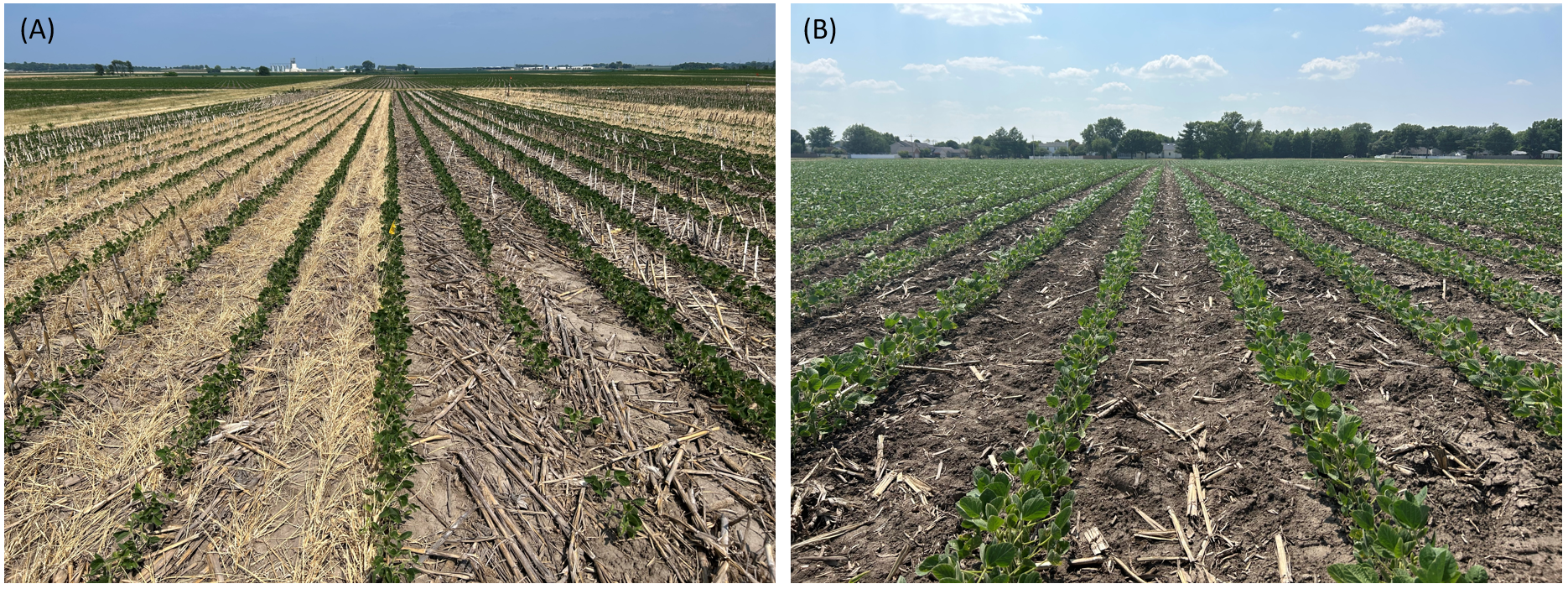Dry Weather and Crop Conditions in Illinois
The first two months of the 2023 growing season have been much like the first two months of the 2022 growing season, with a few key differences. The 2023 crop was planted earlier and into somewhat drier soils – some producers actually waited to plant during part of the second half of April until the weather warmed up. By May 7, 73% of the corn and 66% of the soybean had been planted, compared to the 14% for corn and 10% for soybean from May 7, 2022. Emergence was delayed by cool temperatures in early May this year, and soybean emergence was not as good as corn emergence in fields where it rained soon after planting.
Nearly all of the corn and most of the soybeans began to grow more or less normally after emergence, but depending on planting time and soil type, dry conditions since emergence have affected growth to some extent. Normal rainfall in Illinois between May 1 and June 20 is about 7 inches. This year, only 40 to 50 percent of that amount has fallen in the northern half of the state, and 60 to 70 percent of normal fell in the southern half of Illinois. Temperatures have been close to normal, but low humidity and windy weather at times have caused high evaporation rates. The US Drought Monitor shows the intensity of dry weather continues to increase across the state (Figure 1). By June 20, 18% of Illinois was under unusual dryness, 51% in moderate drought, and 31% in severe drought.

The question on everyone’s mind is what effect the current crop condition might have on yield potential, and how long it can remain in this condition before yield loss accelerates. We’ll consider this and related issues of management for both corn and soybean.
Corn
It’s instructive but maybe a little dangerous to compare this crop to last year’s, but the crop this year is probably in a little better shape than it was at this same stage, which was 7 to 10 days later in 2022 due to later planting. Rainfall that mostly relieved stress in 2022 did not arrive until the beginning of the second week of July, as the crop approached tasseling. That rain helped to get the crop tasseled and pollinated, but pollination was a week or so late due to stress before tasseling. As we know, the 2022 crop ranged from good to outstanding – with a new yield record in Illinois of 214 bushels per acre – despite the dry weather during the first half of the season. But the Illinois corn crop on June 18 was rated at only 36% good + excellent, one of the lowest ratings ever seen, especially so early in the season. On the same date in 2022, despite low rainfall in June last year, 71% of the corn crop was rated good or excellent.
Most of the current corn crop is at about the V8-V12 growth stage, depending on the planting date and how much rain has fallen since planting. Figure 2 is a photo of corn planted near Urbana on April 27; the plants are currently at stage V9. The photo was taken at 4 pm on June 21, and water stress symptoms (leaf rolling) are visible. Note that most of the sunlight is falling on the soil and not on the leaves. The lack of standing water and good soil conditions at planting have helped root system development; but with growth the water around the roots is depleted, and water uptake is declining every day that rains fail to fall. Canopy color may look fair in the morning before leaves begin to curl, but the long period of having less water than needed is beginning to take a toll on the lower leaves. With little or no movement of N below the root zone, and almost no chance of N loss through leaching, there is certainly no reason to consider adding N to the crop if enough N (180 lb or more) has already been applied. Plants that are struggling to take up enough water get no benefit from adding N to the soil, especially when that N is in dry soil where roots are not active.

There is little we can do besides wait and hope that it rains before the potential for producing normal kernel numbers begins to slip. The number of potential kernels per row is set by the V12 and V15 growth stages, which could be by late June or early July. Water usage by the corn crop is high from a week or so before pollination to about midway through grain-filling. Until that happens, we can get a sense of the plant’s photosynthetic rate by the number of hours they spend with leaves curled up each day. Plants that exhibit leaf rolling in the morning are under more stress than those that begin leaf rolling later in the day. Most fields are now at stages where dry soils will start restricting water uptake rates, and this will begin to limit leaf size and stem length. As we saw last year, leaf diseases are likely to remain at low levels as long as dryness persists. Decisions about fungicide application, and other in-season inputs should perhaps be delayed until it becomes clear whether or not crop insurance claims might be necessary.
Soybean
Soybeans have had a little more difficulty dealing with soil dryness than corn, although plants in many fields where some rain has fallen are starting to expand leaf area some and to add height and leaf area. The combination of some cool nights, slow emergence and early growth, and replanting of some frost-killed fields have somewhat limited the opportunities for soybeans to flower before the longest day this year. That was the case last year as well, and the crop did well even though flowering in most fields did not begin until July. Still, the crop rating for Illinois soybeans on June 18, 2023, was only 33% good + excellent, compared to 66% on that date in 2022. We hope that the ratings this year remain reversible, but that will not begin to happen until it rains.
Figure 3 is a photo taken on June 21 of soybeans planted near Urbana on May 12. While these emerged well and have good stands, no-till soybeans (Figure 3A) – especially those following cereal rye cover crop – have grown more slowly than those planted in conventional systems (Figure 3B). Soybeans in no-till cereal rye, no-till without cover crop, and conventional systems were at V3-V4, V4-V5, and V5-V6 growth stages, respectively. Leaves are not as large as usual due to dryness; the large amount of sunlight that fell on the longest day of the year largely hit the soil and provided little benefit to the crop. We can expect that flowering in this field to begin within the next week or so, although dryness may keep the first flowers from setting pods.

As with corn, the only thing we can do in non-irrigated soybean fields is to hope for a change in weather pattern that brings rain to reverse the decline. Plants in most fields are healthy, although dry soils can increase injury from soybean cyst nematode. In part because leaf growth is slow, herbicide injury may remain visible longer than usual: new leaf growth is how such injury “disappears” over time. Unlike corn, soybeans accumulate <15% of their total biomass by R1 or the first flower, meaning that little water is utilized during vegetative growth. The critical period for soybean yield begins later, and last longer than for corn, and as long as soils have enough moisture by early to mid-July, yield potential should be good. As we saw last year, temperature and moisture conditions were favorable for filling soybean pods, and the 63-bushel state yield was only one bushel less than the highest on record (in 2021).





